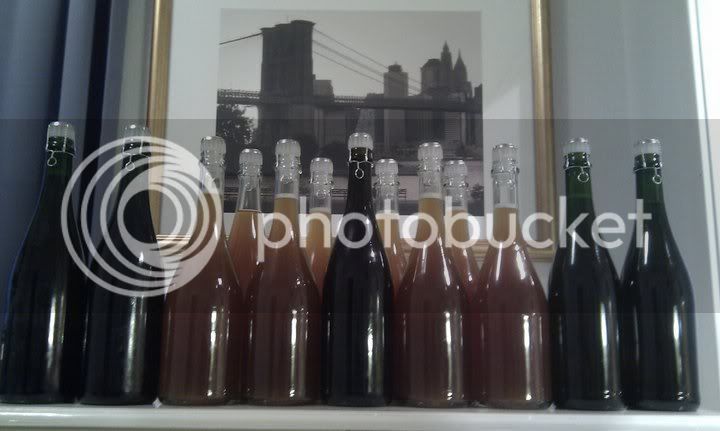RIT_Warrior
Well-Known Member
I really like the "Belgian style" corked bottles that many Belgian beers come in, and I'd love to use them for bottling. Unfortunately, corks and corkers are expensive and I don't really have the space in my apartment to use and store a proper floor corker. However, I recently discovered plastic corks which can be inserted by hand! These have been reported by others on here with mixed success, the most common complaint being that some of the bottles don't carb up properly.
Since I really want to use the Belgian bottles, I decided to do an experiment. I bought 100 plastic corks and 100 metal traps, and I broke out some Belgian style bottles I've been saving just in case I can use them in the future.
Without further ado, here is the experiment:
Equipment:
I'll be using 5 different bottles for the first run. They are:
Dogfish Head Sah'Tea
Chimay Red
Affligem Dubbel
Ommegang Three Philosophers
Unibroue Terrible
More bottles will be coming as I acquire them. I have a Westmalle Dubbel that I'll use as well when I get around to drinking it (in a month or so).
The corks are distributed by crosby and baker. I think they say "Lokorb" on the top, but it is kind of hard to read. The traps are your standard wire dealies without the plate you see on most commercial examples.
I'll be using Coopers carb tabs (2 per bottle) and dry bread yeast (I bet I'll get some flak for this). Plain tap water will be the only ingredient that goes in the bottles. After 2 weeks or so I'll pop the bottles in the fridge for a couple of days and find out if they held pressure.
Assumptions:
I'm assuming that all bottles from one company are the same, so if the Ommegang bottle carbs up I'll assume all Ommegang bottles will carb up correctly. This might be a bad assumption, but it is sort of the best I can do with limited resources.

Sorry for the terrible picture.
Initial observations:
I used way too much yeast, but I don't really care for the purposes of this experiment, as long as they eat the sugar.
As for the corks, I managed to get all of them in by hand. The dogfish head's cork went in about as easy as your cat goes into a travel cage before you take it to the vet. I don't expect a leak in that one. The Unibroue's cork went in much easier, I'd pick that one to fail before any of the others.
The other three felt about the same, I figure all of them should carb up OK with no issues.
Since I really want to use the Belgian bottles, I decided to do an experiment. I bought 100 plastic corks and 100 metal traps, and I broke out some Belgian style bottles I've been saving just in case I can use them in the future.
Without further ado, here is the experiment:
Equipment:
I'll be using 5 different bottles for the first run. They are:
Dogfish Head Sah'Tea
Chimay Red
Affligem Dubbel
Ommegang Three Philosophers
Unibroue Terrible
More bottles will be coming as I acquire them. I have a Westmalle Dubbel that I'll use as well when I get around to drinking it (in a month or so).
The corks are distributed by crosby and baker. I think they say "Lokorb" on the top, but it is kind of hard to read. The traps are your standard wire dealies without the plate you see on most commercial examples.
I'll be using Coopers carb tabs (2 per bottle) and dry bread yeast (I bet I'll get some flak for this). Plain tap water will be the only ingredient that goes in the bottles. After 2 weeks or so I'll pop the bottles in the fridge for a couple of days and find out if they held pressure.
Assumptions:
I'm assuming that all bottles from one company are the same, so if the Ommegang bottle carbs up I'll assume all Ommegang bottles will carb up correctly. This might be a bad assumption, but it is sort of the best I can do with limited resources.

Sorry for the terrible picture.
Initial observations:
I used way too much yeast, but I don't really care for the purposes of this experiment, as long as they eat the sugar.
As for the corks, I managed to get all of them in by hand. The dogfish head's cork went in about as easy as your cat goes into a travel cage before you take it to the vet. I don't expect a leak in that one. The Unibroue's cork went in much easier, I'd pick that one to fail before any of the others.
The other three felt about the same, I figure all of them should carb up OK with no issues.




